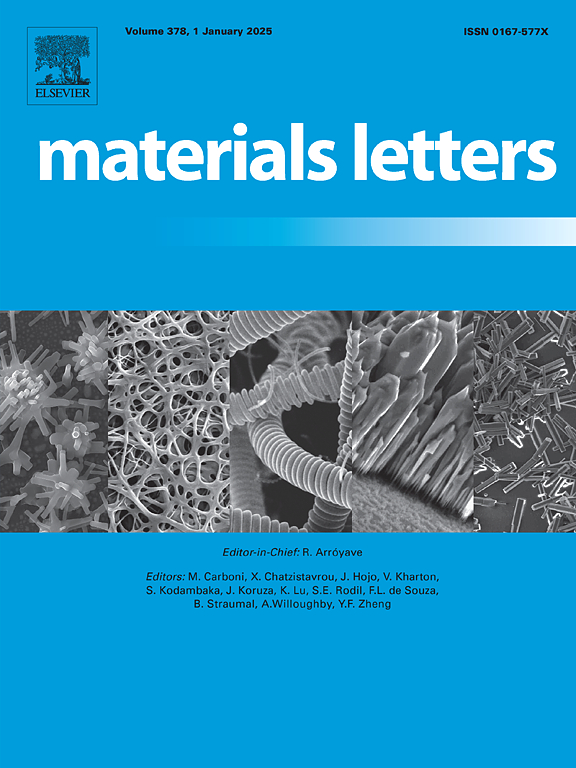Tubular carbon nitride composite with Ni/MoO2 as an electrocatalyst to accelerate the conversion of lithium polysulfide in lithium-sulfur batteries
IF 2.7
4区 材料科学
Q3 MATERIALS SCIENCE, MULTIDISCIPLINARY
引用次数: 0
Abstract
Lithium-sulfur batteries (LSBs) are considered to be one of the most promising candidates for next-generation rechargeable batteries, owing to their high specific theoretical capacity and ecological friendliness. Nevertheless, the dumb shuttle effect of lithium polysulfide (LiPSs) and their slow reaction kinetics hinder the practical application of LSBs. Herein, nickel composite with molybdenum dioxide particles based on tubular carbon nitride (Ni/MoO2/CN) is successfully constructed to achieve the adsorption of LiPSs and promote the kinetics of their conversion. The adsorption experiments and kinetic tests indicate that the composite material demonstrates significant confinement and catalytic capability for LiPSs, which effectively suppressing the shuttle effect. As a result, the battery with Ni/MoO2/CN modified separator exhibits a impressive rate performance (927 mAh g−1 at 1C) and long cycle stability (1000 cycles, with a capacity decay rate of 0.05 % per cycle) was achieved at 3C. This study helps to further promote the development of electrocatalysts for high-performance LSBs.

以Ni/MoO2为电催化剂的管状氮化碳复合材料加速锂硫电池中多硫化锂的转化
锂硫电池(LSBs)由于具有较高的理论比容量和生态友好性,被认为是下一代可充电电池最有前途的候选材料之一。然而,多硫化锂(LiPSs)的哑梭效应及其缓慢的反应动力学阻碍了其实际应用。本文成功构建了基于管状氮化碳(Ni/MoO2/CN)的镍与二氧化钼颗粒复合材料,以实现对LiPSs的吸附并促进其转化动力学。吸附实验和动力学测试表明,复合材料对LiPSs具有明显的约束和催化能力,有效抑制了穿梭效应。结果表明,采用Ni/MoO2/CN改性隔膜的电池在1C下表现出令人印象深刻的倍率性能(927 mAh g−1),并且在3C下实现了长周期稳定性(1000次循环,每次循环的容量衰减率为0.05%)。该研究有助于进一步推动高性能lbs电催化剂的发展。
本文章由计算机程序翻译,如有差异,请以英文原文为准。
求助全文
约1分钟内获得全文
求助全文
来源期刊

Materials Letters
工程技术-材料科学:综合
CiteScore
5.60
自引率
3.30%
发文量
1948
审稿时长
50 days
期刊介绍:
Materials Letters has an open access mirror journal Materials Letters: X, sharing the same aims and scope, editorial team, submission system and rigorous peer review.
Materials Letters is dedicated to publishing novel, cutting edge reports of broad interest to the materials community. The journal provides a forum for materials scientists and engineers, physicists, and chemists to rapidly communicate on the most important topics in the field of materials.
Contributions include, but are not limited to, a variety of topics such as:
• Materials - Metals and alloys, amorphous solids, ceramics, composites, polymers, semiconductors
• Applications - Structural, opto-electronic, magnetic, medical, MEMS, sensors, smart
• Characterization - Analytical, microscopy, scanning probes, nanoscopic, optical, electrical, magnetic, acoustic, spectroscopic, diffraction
• Novel Materials - Micro and nanostructures (nanowires, nanotubes, nanoparticles), nanocomposites, thin films, superlattices, quantum dots.
• Processing - Crystal growth, thin film processing, sol-gel processing, mechanical processing, assembly, nanocrystalline processing.
• Properties - Mechanical, magnetic, optical, electrical, ferroelectric, thermal, interfacial, transport, thermodynamic
• Synthesis - Quenching, solid state, solidification, solution synthesis, vapor deposition, high pressure, explosive
 求助内容:
求助内容: 应助结果提醒方式:
应助结果提醒方式:


